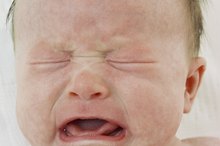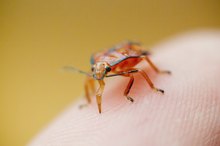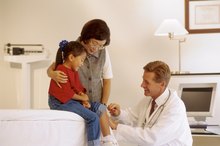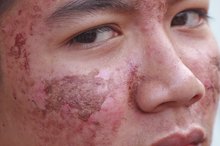What does fact checked mean?
At Healthfully, we strive to deliver objective content that is accurate and up-to-date. Our team periodically reviews articles in order to ensure content quality. The sources cited below consist of evidence from peer-reviewed journals, prominent medical organizations, academic associations, and government data.
- Paediatrics & Child Health: Skin Care for Your Baby
- Paediatrics & Child Health: Skin Care for Your Baby
The information contained on this site is for informational purposes only, and should not be used as a substitute for the advice of a professional health care provider. Please check with the appropriate physician regarding health questions and concerns. Although we strive to deliver accurate and up-to-date information, no guarantee to that effect is made.
Red Bumps on Babies' Skin
Although unsightly bumps and blemishes marring your baby’s soft skin might be an unpleasant surprise, rashes and skin conditions are very common in newborns and infants. Since it can be difficult to differentiate minor concerns, such as bug bites or heat rashes, from more serious conditions, like allergic reactions, it is important to take your child to the doctor for an evaluation so he or she can accurately diagnose and treat the bumps.
Types
The most common cause of red bumps on a baby’s skin is diaper rash. If the red bumps occur outside of the diaper area, other possible causes include baby acne, eczema, viral rashes, erythema toxicum, heat rash, contact rash and hives.cause:
- If the red bumps occur outside of the diaper area
- other possible causes include baby acne
- eczema
- viral rashes
- erythema toxicum
- heat rash
- contact rash
- hives
Many of these rashes appear quite similar, but the trained eye of your child’s doctor – along with relevant background information on the rash – can usually help him or her diagnose the cause of your baby’s skin condition 3.
Time Frame
Blotchy Skin Rash on a Baby's Face
Learn More
When trying to identify the cause of the bumps, it is important to consider your baby’s age. Baby acne, which can mar your baby’s face with clusters of red bumps, often occurs within three to four weeks of her birth. Erythema toxicum – a skin condition that causes flat red spots with a pimple-like bump in the middle – appears after 5 days of age and disappears on its own within 7 to 14 days. Although newborns can experience allergic rashes, like hives and eczema, these occur more commonly in two-to-six-month old babies.
- When trying to identify the cause of the bumps, it is important to consider your baby’s age.
- Baby acne, which can mar your baby’s face with clusters of red bumps, often occurs within three to four weeks of her birth.
Considerations
Since babies cannot move away from bugs or tell you when one bites them, they are especially vulnerable to bug bites. These bites can occur in any season and in any type of home -- even clean, pet-free ones. Bug bites might be the culprit behind your baby’s red bites if there are less than 20 bumps present and if you can see a tiny hole in the middle of the bump.
Prevention/Solution
Red Bumps on the Trunk of the Body
Learn More
Since infants do not sweat, they frequently experience heat rash – a condition that causes tiny red bumps or pimples – when the pores that lead to their sweat glands are blocked. This condition occurs most commonly in hot or humid weather, although it can also happen if you over-bundle or over-dress your newborn in cooler weather. Talk to your baby's doctor about treating heat rash by cooling your baby off and applying a cool washcloth to the affected area.
Warning
The viral illness, roseola, causes a high fever along with a red spotty rash that starts on the upper back and neck and spreads to your child’s trunk and extremities. Although the illness usually disappears on its own without complications, high fever can cause febrile seizures in some children. These seizures are usually harmless, but they can be terrifying for both parents and children. Call your doctor promptly if your baby experiences a febrile seizure.
- The viral illness, roseola, causes a high fever along with a red spotty rash that starts on the upper back and neck and spreads to your child’s trunk and extremities.
- Although the illness usually disappears on its own without complications, high fever can cause febrile seizures in some children.
Related Articles
References
- British Columbia Centre for Disease Control: A Quick Guide to Childhood Diseases
- American Family Physician: Newborn Skin -- Part 1. Common Rashes
- Paediatrics & Child Health: Skin Care for Your Baby
- Martin PE, Eckert JK, Koplin JJ, et al. Which infants with eczema are at risk of food allergy? Results from a population-based cohort. Clin Exp Allergy. 2015;45(1):255-64. doi:10.1111/cea.12406
- Waserman S. Doctor, can we prevent food allergy and eczema in our baby?. Curr Opin Allergy Clin Immunol. 2016;16(3):265-71. doi:10.1097/ACI.0000000000000267
- Wopereis H, Sim K, Shaw A, Warner JO, Knol J, Kroll JS. Intestinal microbiota in infants at high risk for allergy: Effects of prebiotics and role in eczema development. J Allergy Clin Immunol. 2018;141(4):1334-1342.e5. doi:10.1016/j.jaci.2017.05.054
Writer Bio
A former children's librarian and teacher living in Dallas, Erin Carson loves to share her knowledge of both literature and parenting through her writing. Carson has a master's degree in library science and a bachelor's degree in English literature. As a freelance writer, Carson has published numerous articles on various websites.








